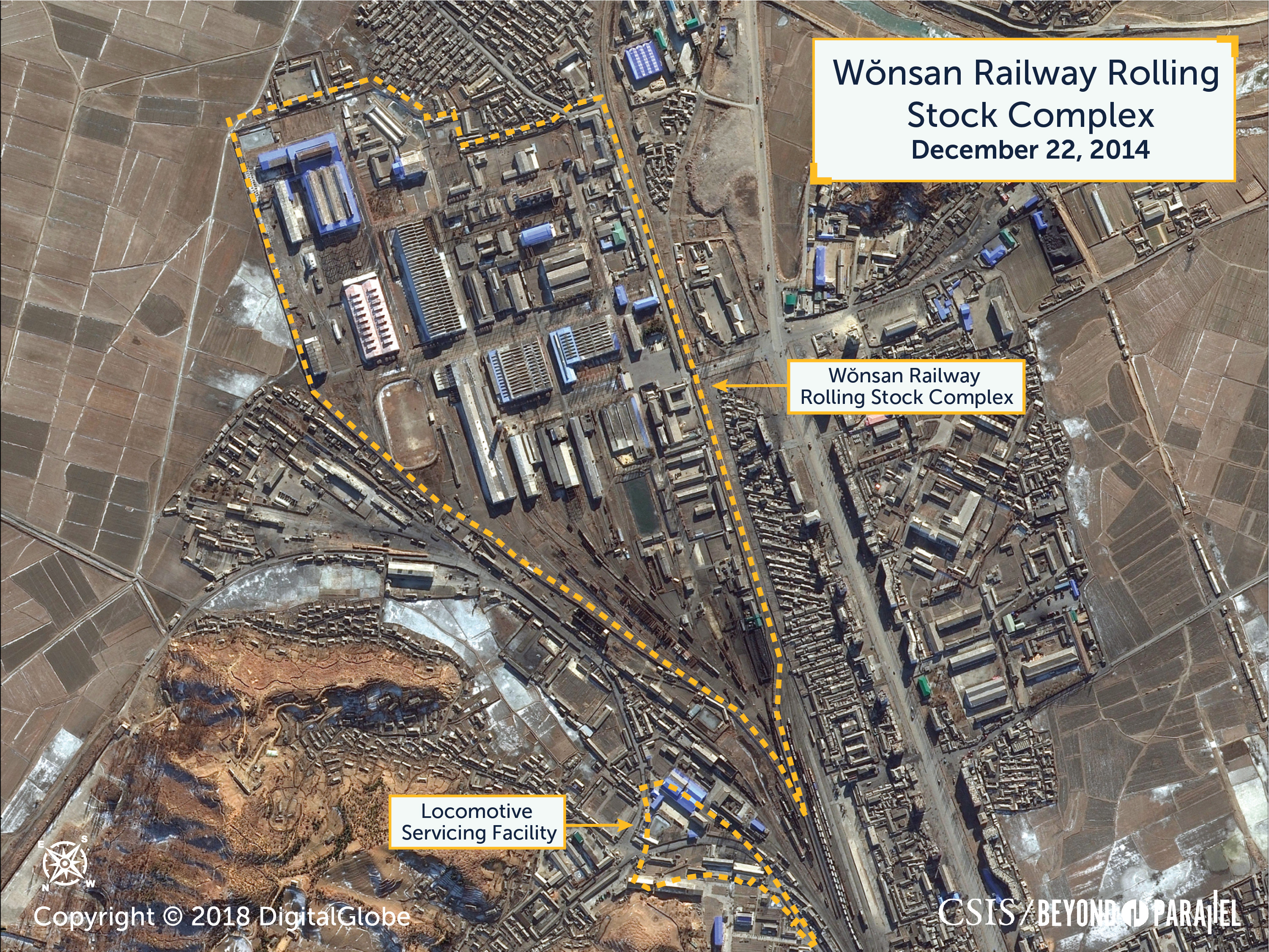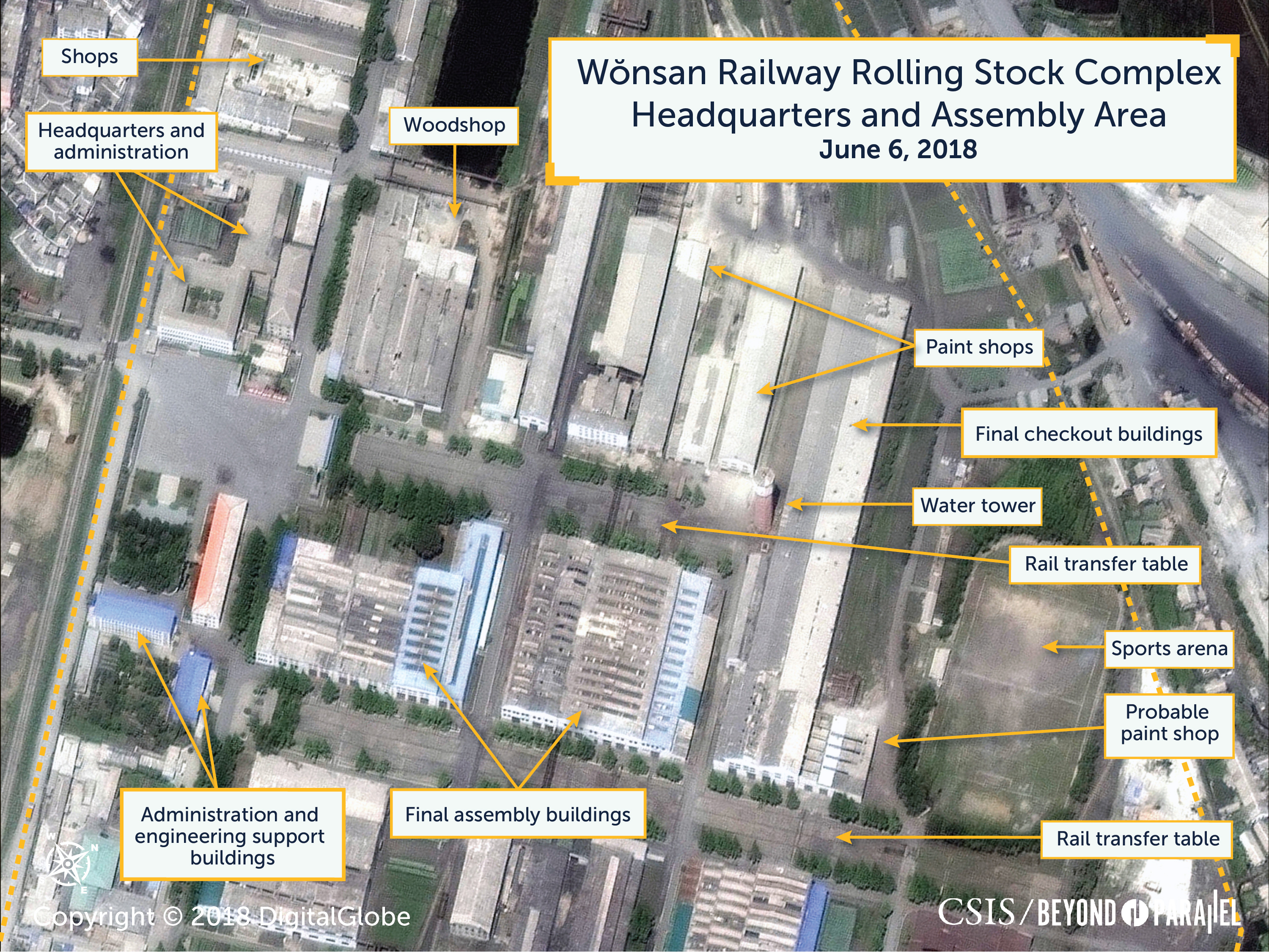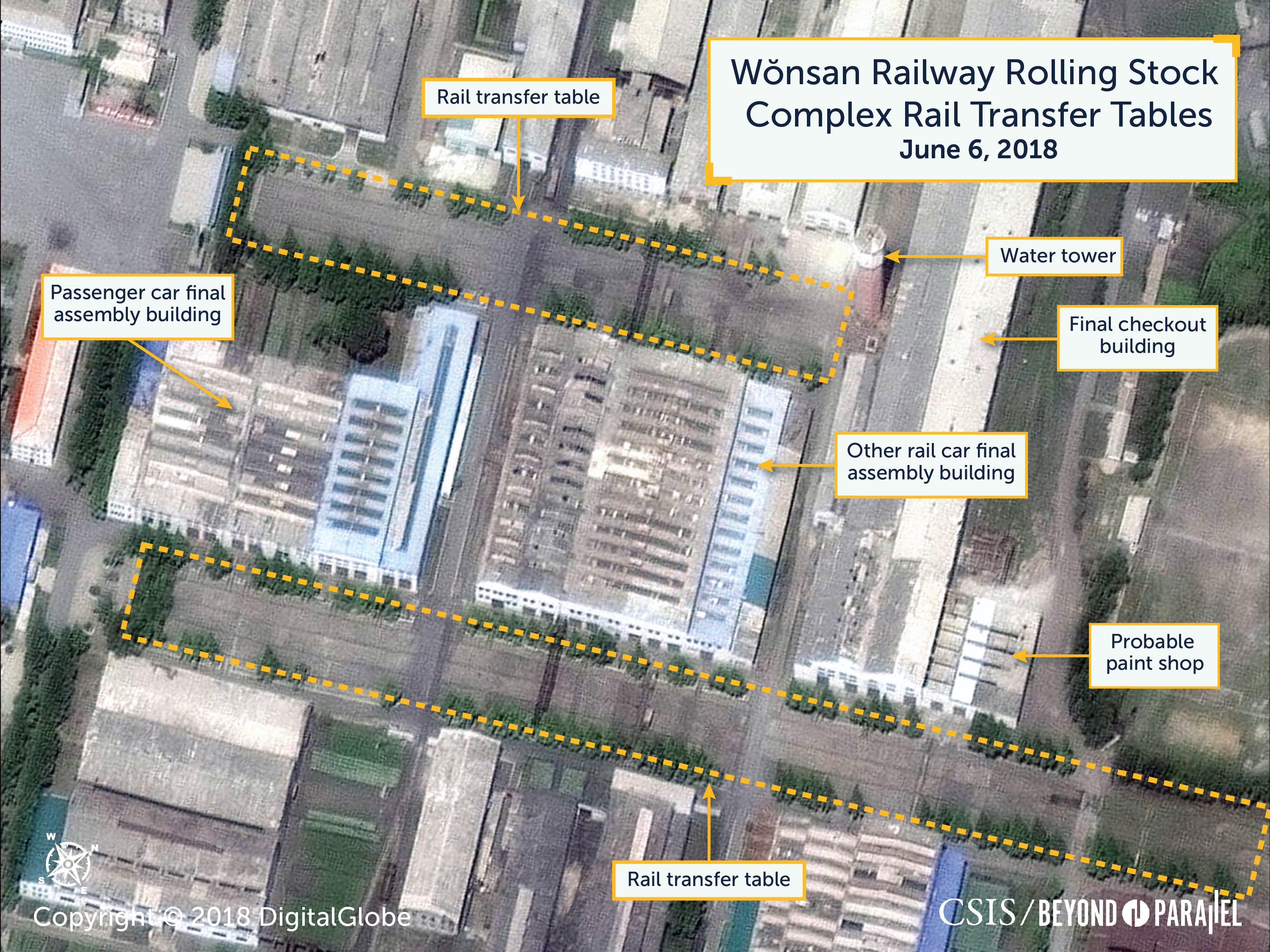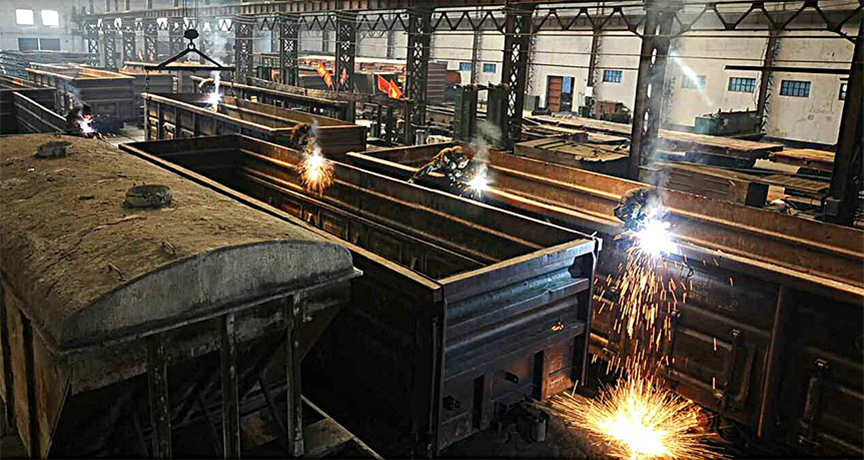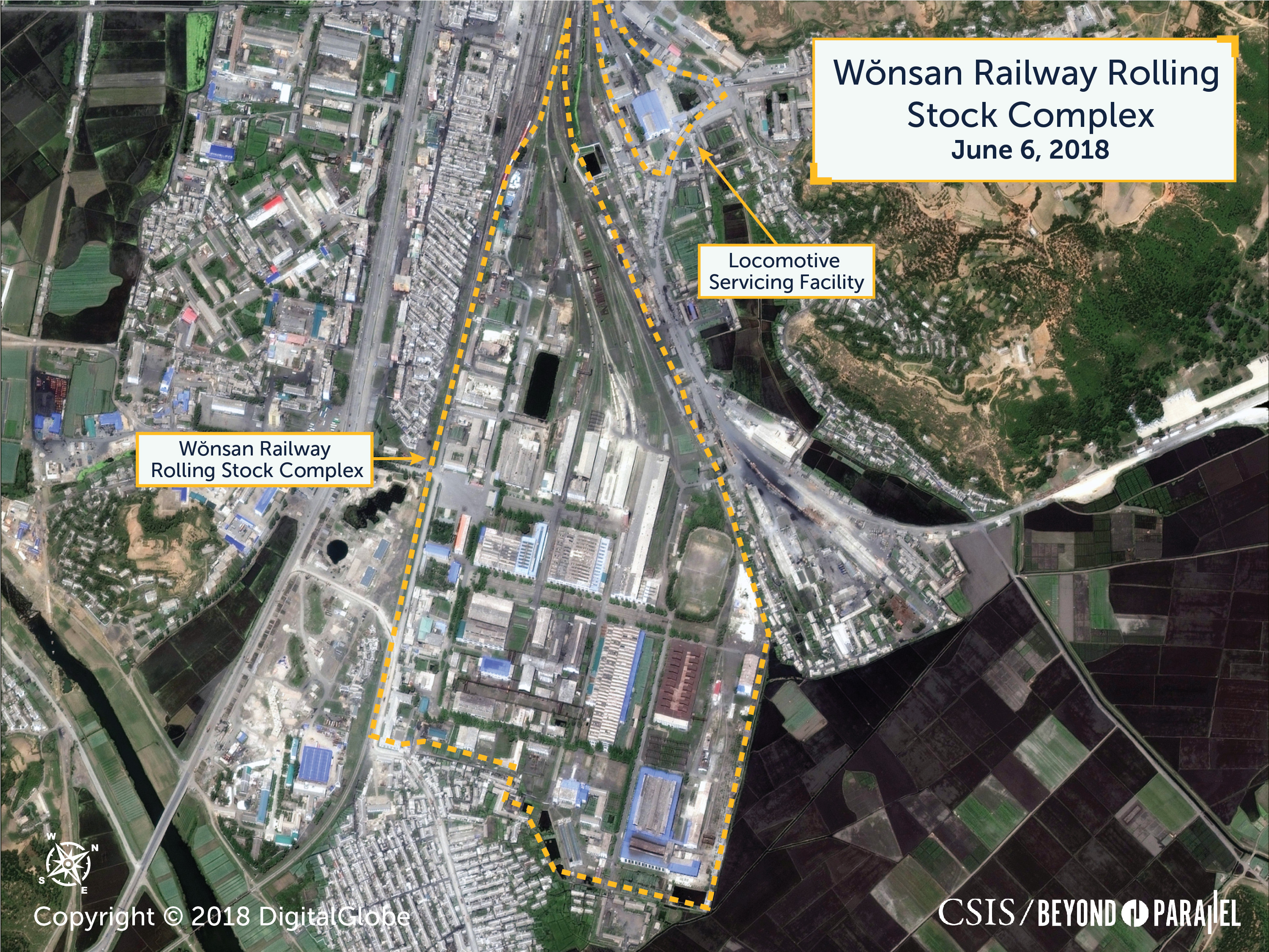
North Korean Railways and Reconnections? Wonsan Railway Rolling Stock Complex
Connection and modernization of railways in the Korean peninsula’s eastern transportation corridor are declared steps within the historic April 27, 2018, joint declaration for peace, prosperity, and unification and a long-discussed hope among regional powers. Should the agreement be substantially executed and international rapprochement lead to new opportunities for infrastructure development assistance to North Korea, activity around Wonsan is likely to be a leading indication of change given its role both in the eastern transportation corridor and the national economy.
The Wonsan Railway Rolling Stock Complex is the largest manufacturing and repair facility for railcars in the nation. Analysis of this facility could likely provide an early brick-and-mortar signpost progress if rapprochement leads to new opportunities for infrastructure development assistance and the trust-building project of reconnecting the Koreas’ railways is carried out.
Railroads and railway facilities serve as the vital link underpinning North Korea’s underdeveloped economy. Together they present both new possibilities for inter-Korean relations and regional economic cooperation and foundational infrastructure for future unification. However, knowledge of North Korea’s infrastructure is lacking, according to a pilot survey of regional experts conducted by CSIS Beyond Parallel. This study of North Korea’s Wonsan Railway Rolling Stock Complex builds upon our previous report of the Chongjin Railway Factory and together these reports begin to address that void.
Commercial satellite imagery shows that the Wonsan Railway Rolling Stock Complex is currently active and appears to be well maintained by North Korean standards. In addition to its production and repair responsibilities, the complex serves as a center for North Korean railroad technical research and development.
North Korea’s railroad system, with over 7,400 kilometers (km) of track, is critical both to the North Korean economy and national defense, serving as the primary means for the country’s long-haul cargo and passenger transportation.
According to the official North Korea 2009 census, Wonsan city is North Korea’s fifth-largest city by population size and is the capital of Kangwon province on North Korea’s east coast. The city also serves as an important transportation hub with a relatively good highway connection to Pyongyang, an airport, a port, and the Kangwon railway line. Wonsan is best known to the world as a tourist destination. Its importance as such is highlighted by Kim Jong-un’s specific mention in his 2018 New Year’s address calling for completion “in the shortest period of time” of the Wonsan-Kalma tourist area and paying a visit to give on-the-spot guidance in the spring. This has interesting implications for the economic development of industry in the city as large industrial expansion seems unlikely.1 Even so, Wonsan is home to a handful of light and heavy industries with a dozen or so important companies, including the Wonsan Rolling Stock Complex. The city’s industries include steel, shipbuilding, cement, shoes, textiles, tractors, fisheries, and others. There are also a number of universities and at least one research institute in Wonsan. Wonsan’s port boasts the greatest length of dock space in the country at approximately 3,166 meters. (Though the port’s cargo and coal handling capacity is significantly less than the ports in Chongjin and Nampho.)
Despite being eclipsed in recent news by the tourist zone development, the Wonsan Railway Rolling Stock Complex plays an important role in the city as well as in the regional and national economies. As efforts progress to modernize and reconnect the eastern transportation corridor between North and South Korea under the April 27 Panmunjeom Declaration, a joint declaration for peace, prosperity, and unification, the railcars produced and serviced at the complex could play an increasingly important role. The Wonsan Rolling Stock Complex is one of just five major industrial facilities that undertake railcar production and depot-level repairs for the nationwide network.

Of these national facilities, the Wonsan Railway Rolling Stock Complex is the largest manufacturing and repair facility for railroad railcars (also called rolling stock) in the nation. It also undertakes repairs to diesel, electric, and steam locomotives, although it is not known to produce them. As such it represents an indispensable component of both North Korea’s economy and national defense.2
Located in the southern section of the port city of Wonsan, Kangwon Province, adjacent to the Kalma Rail Station, the Wonsan Railway Rolling Stock Complex (39.140053° 127.475910°) manufactures and repairs railway rolling stock; repairs steam, diesel, and electric locomotives; and produces railcar and locomotive components and sub-systems. As of June 2018, commercial satellite imagery shows that the complex is active and appears well maintained by North Korean standards.
Although North Korean media presents a picture of the facility working at full potential, the production capacity and actual output levels for the Wonsan Railway Rolling Stock Complex are unknown. Some dated reports indicate a possible annual production capacity of up to 200 passenger and 2,000 freight cars.3
Commercial satellite imagery and domestic reporting with ground imagery indicate that the complex produces or repairs a wide range of railcars, including 40-ton flat cars, 60-, 100-, and potentially 125-ton ore cars, box/refrigerator, two-bay hopper (covered and uncovered), log/lumber, gondolas, passenger cars, and tank. Although none were seen in either satellite and ground imagery, the complex likely produces and repairs specialized maintenance-of-way (MoW) and industrial cars. Additionally, it repairs locomotives (diesel, electric, and steam). The complex may also engage in small-scale scrapping of railcars and locomotives, and the recovery of reusable components.4
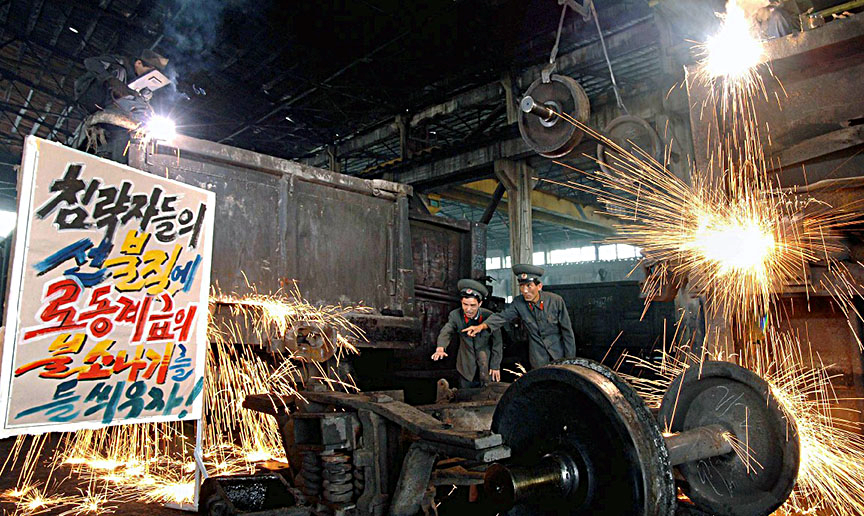
In addition to its production and repair responsibilities, the Wonsan Railway Rolling Stock Complex serves as a center for railroad technical research and development. Scientists and technicians from the complex work with researchers from the Railway Science Branch of the State Academy of Sciences and publish their work in North Korean scientific and technical journals.5
Attesting to the complex’s importance to the nation over the years, Kim Il-sung, Kim Jong-il, and senior officials have visited the factory on a number of occasions and it has been frequently mentioned in North Korean media.6 There are, however, no readily available reports of Kim Jong-un visiting the factory since he came to power. Among the senior leaders to have visited the complex in recent years was Choe Ryong Hae, vice-chairman of the State Affairs Commission, and vice-chairman of the Worker’s Party of Korea’s Central Committee.7
The complex encompasses an irregular-shaped, fenced-in area of approximately 540,000 m2 (133 acres) and can be broken down into three functional areas: administration, engineering, and support; manufacturing and repair; and rail yard.
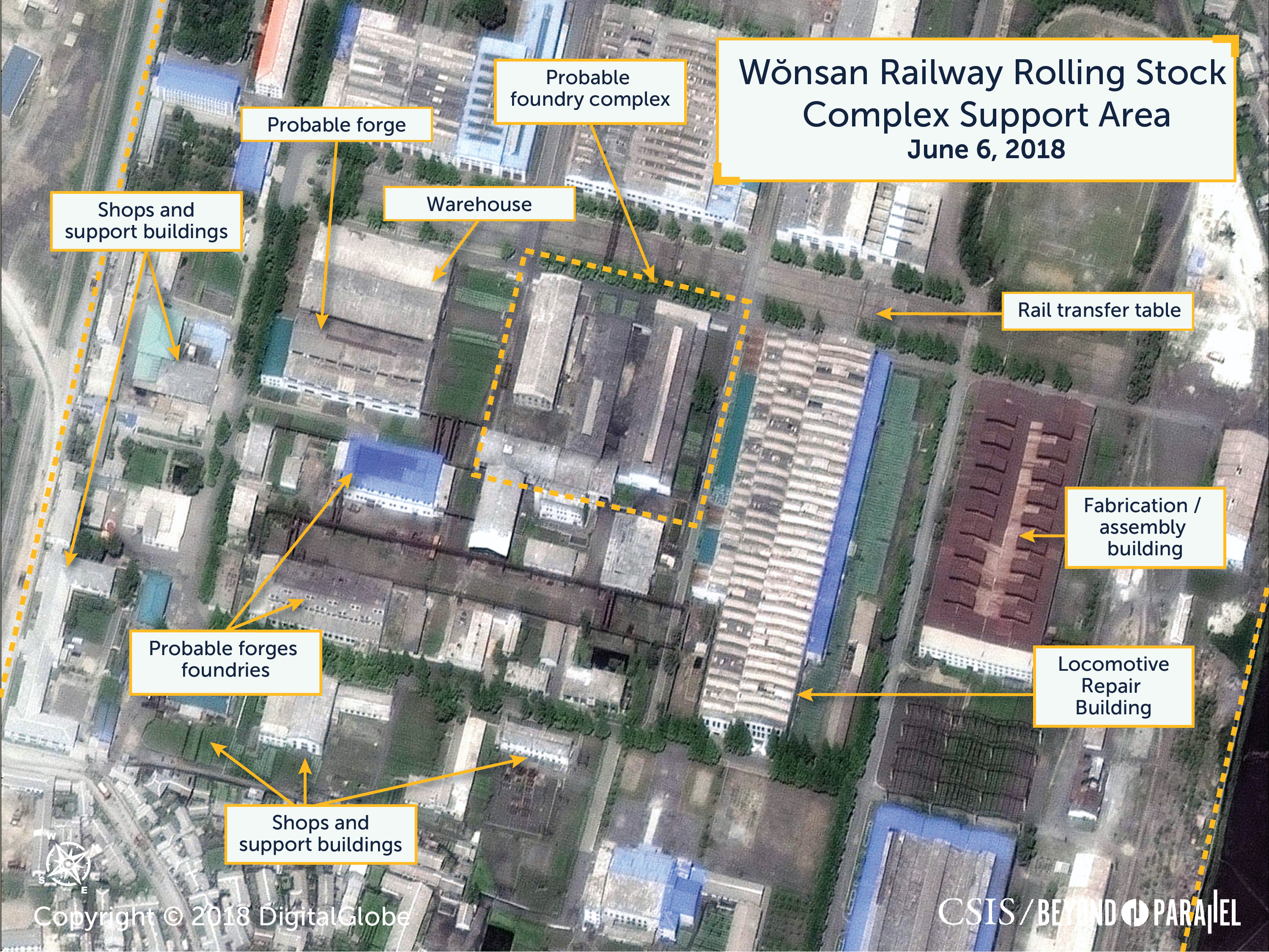
The administrative facilities are generally concentrated along the southwest side of the complex. The manufacturing and repair facilities occupy the center of the complex—most notably 10 large assembly, repair, and fabrication halls. These halls are connected by two rail transfer tables—the largest being approximately 420-meters-long—that move heavy parts, subassemblies, and railcars from building to building or between bays in the same building.
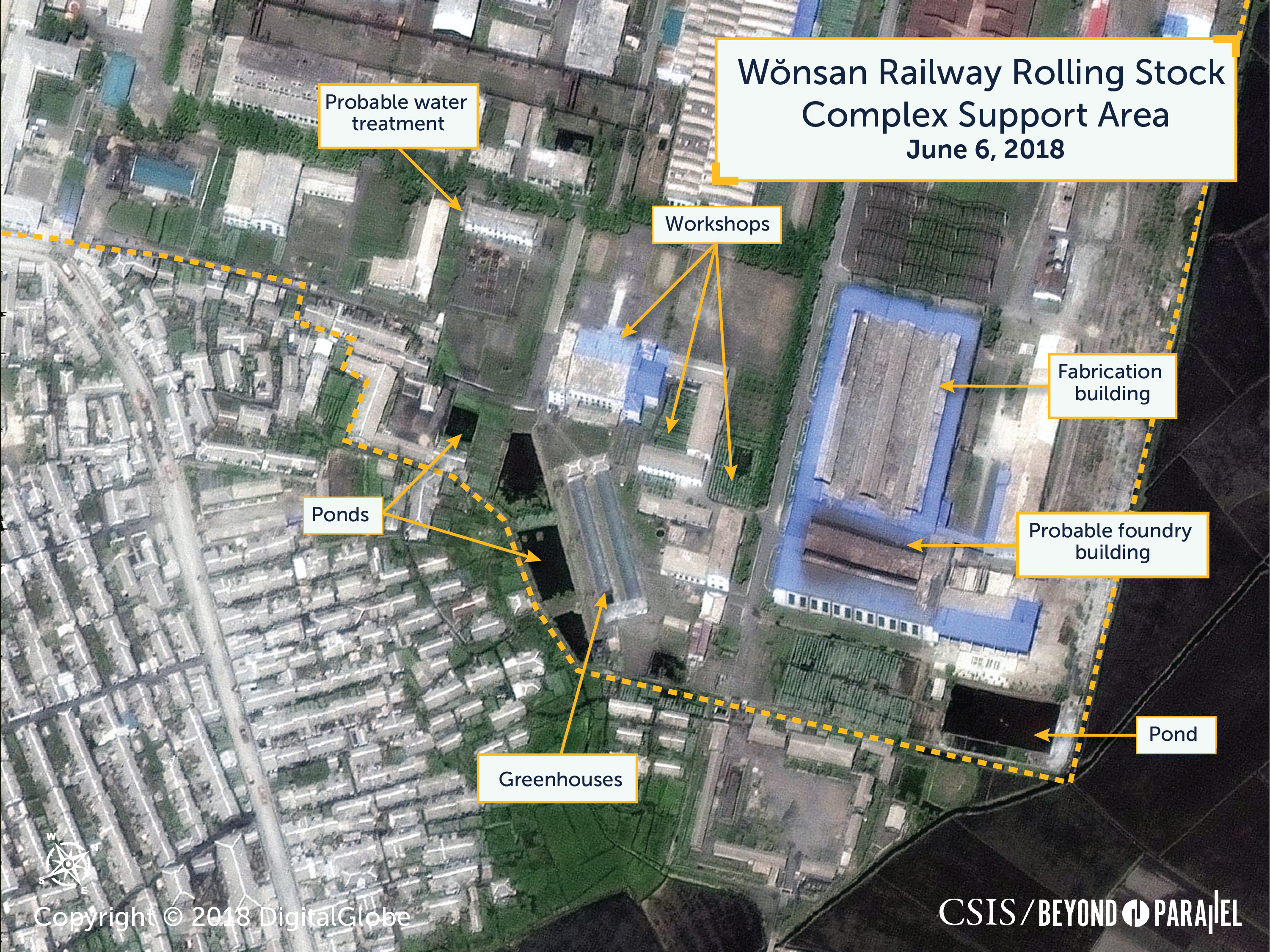
The engineering and support facilities (fabrication shops, forges/foundries, sheds, greenhouse, miscellaneous structures) are located along the northwest side and south-central section of the facility. These support facilities reportedly use some computer numerically controlled (CNC) equipment and appear to manufacture almost all the components (e.g., road wheels, trucks, springs, couplers) from both semi-finished components and raw materials required for production and repair operations.8 On the north side of this section is a basin used for storing logs before they are brought into the adjacent woodworking shop. There are also several greenhouses located around the complex and what appears to be a water treatment plant in the southeast corner.

The rail yard is stub-ended and is served by a compound ladder with approximately 20 tracks of various lengths and functions (e.g., shipping, receiving, holding, classification). In the center of the rail yard is an open-air storage yard. Immediately north of the complex is a separate facility that appears to be for locomotive servicing (e.g., fueling, sanding, washing, minor maintenance). It is unclear if this is formally part of the complex.
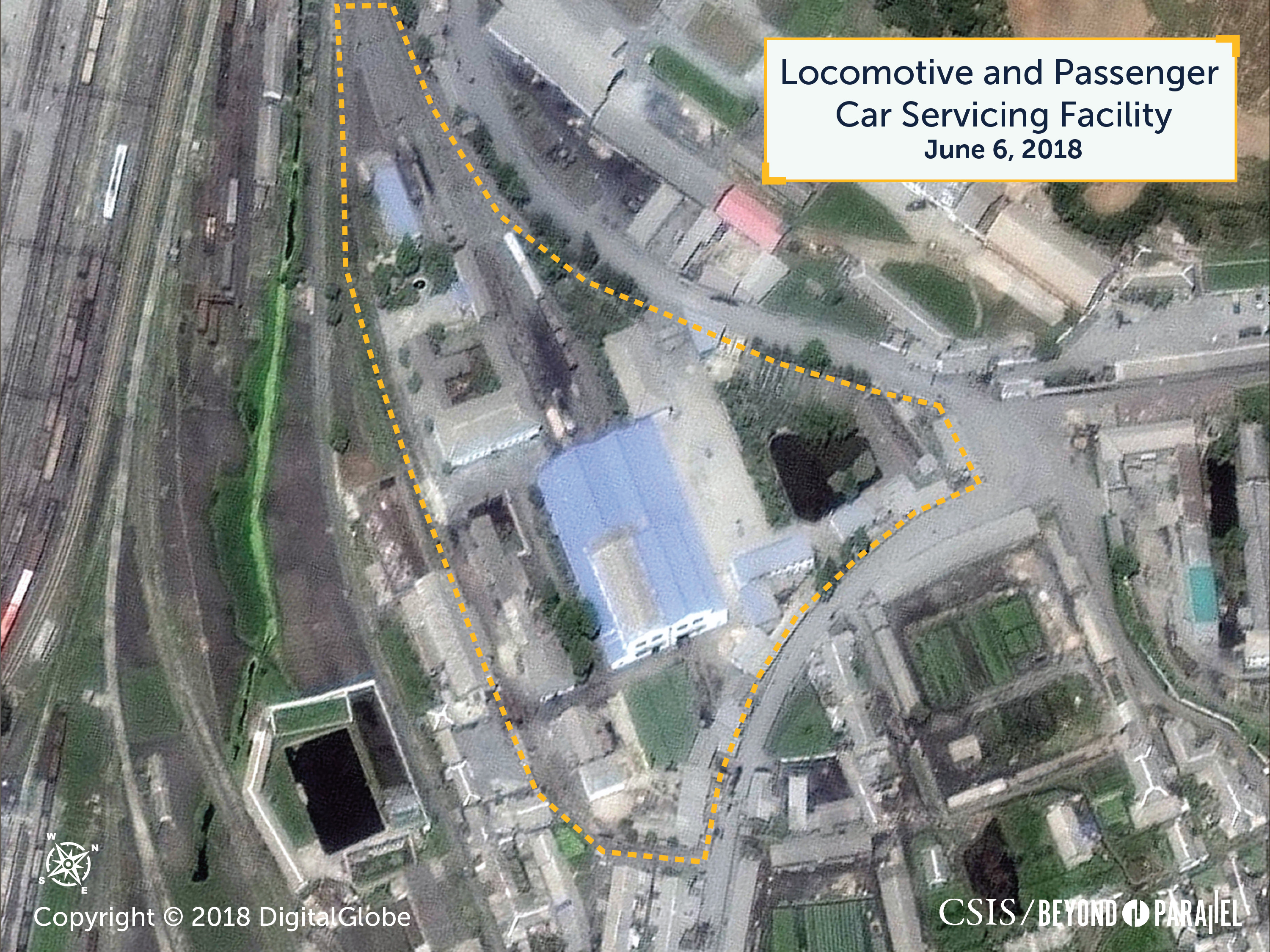
Commercial satellite imagery from 2014 through 2018 shows that the total number of railcars observed at the complex has varied from a high of 88 on December 22, 2014, to a low of 59 on June 6, 2018 (these numbers include the adjacent engine servicing facility).9 This should not necessarily be taken as an indication of slowing output at the complex as each image examined for this report shows both significant differences in the numbers and types of railcars present and their positioning within the facility. Instead, this suggests a dynamic production and repair facility responding to shifting demands for rolling stock and the availability of semi-finished products and raw material. For example, among the railcars present in a December 2014 image were approximately 29 ore cars/gondolas, 12 boxcars, and 28 passenger cars. In a June 2018 image there were approximately 17 ore cars/gondolas, 22 boxcars, and 9 passenger cars. As railcar production and repair are heavily dependent upon steel, and to a lesser degree upon iron and aluminum, fluctuations in the supply of these materials undoubtedly affect the output at the Wonsan Railway Rolling Stock Complex.
None of the North Korean media ground imagery reviewed for this report shows either modern manufacturing equipment or techniques employed at the Wonsan Railway Rolling Stock Complex. Therefore, the production output is likely significantly lower in quantity and quality to similar-sized facilities in Asia or the West. Additionally, this ground imagery shows a facility that is in need of significant infrastructure maintenance and numerous unaddressed safety issues. Should foreign financial investment be directed to the complex in the future, a substantial amount will likely be absorbed in addressing these issues before any meaningful profit be realized.
Obvious in summer or fall imagery of the complex is that a significant portion of all open spaces is being used for gardening. Such gardening is typical of large industrial facilities in North Korea; however, unlike the Chongjin Railway Factory, the tracks at the Wonsan Railway Rolling Stock Complex are generally well maintained, ballasted, and relatively clear of gardening activity, indicating active use.
Looking Ahead
If, going forward, the April 27 inter-Korean agreement is substantially executed and rapprochement leads to new opportunities for infrastructure development assistance to North Korea, activity around Wonsan is likely to provide an early and leading indicator of change given its role both in the eastern transportation corridor and the national economy. Furthermore, evidence of high-level visits to the site would be a significant sign of heightened priority being given by North Korean leadership to transportation infrastructure development and improvements.
Signposts of Policy Significance
- High-level visits to the Wonsan Railway Rolling Stock Complex by Kim Jong-un or other high-level officials.
- High-level visits by delegation from China, Russia, South Korea, or international financial institutions.
- Progress being made in inter-Korean efforts toward the connection and modernization of other parts of the railway network in the eastern transportation corridor.
- Improvements underway at any of Wonsan Railway Rolling Stock Complex’s four sister facilities.

References
- North Korea’s 2013 “General blueprint for the Wonsan District” laid out plans to close aging factories in order to create zones for tourism. (Rainer Dormels, “North Korea’s Cities,” Jimoongdang, Seoul, 2014.) ↩
- Central Intelligence Agency, “CIA Facebook: Korea, North,” https://www.cia.gov/library/publications/the-world-factbook/geos/kn.html, accessed April 25, 2018; and Chiang Hsun, “Hong Kong Businessman Breaks Bottleneck of China-North Korea Railway Transportation,” Yazhou Zhoukan, October 2005, No. 44, http://www.yzzk.com. ↩
- Dormels, “North Korea’s Cities.” ↩
- “New Heavy-duty Wagon Manufactured in DPRK,” KCNA, December 1, 2016; and Namgung Yong, North Korea’s Industrial Infrastructure (Seoul: North Korea Research Team), Research Report No. 94-05, February 26, 1996. ↩
- Scientists and technicians from the complex have been mentioned numerous times in North Korean media. For example, KCNA, December 15, 2017; Palmyo’ng Kongbo, October 5, 2005, 41; Kisul Hyo’ksin, November 5, 2005, 23; Palmyo’ng Kongbo, July 5, 2005, 52; Kisul Hyo’ksin, July 5, 2005, 36; and Kisul Hyo’ksin, March 5, 2005, 14. The facility’s technical achievements have been noted since then. For example, Ji Nam Il, Sim Hyon Jin, and Pang Un Hye, “Nation’s Arterial Industry in Good Maintenance,” Korea Today, Juche 108, No. 4, April 2009, and KCTV, May 2, 2018. ↩
- For example, KCNA, January 19, 2007; KCTV, November 26, 2002; and KCBS, October 23, 2002. ↩
- “Choe Ryong Hae Inspects Units in Kangwon Province,” KCNA, June 22, 2017. ↩
- “Kangwon Province of DPRK Hastens Economic Construction,” KCNA, July 2016. ↩
- These numbers should be viewed as approximations as they only count the railcars within the complex and engine servicing facility, not the adjacent Kalma Rail Station and holding yard. Additionally, the numbers do not account for the limited number of satellite images reviewed or seasonality. A more comprehensive study would likely provide a more nuanced understanding and reveal an explanation for the apparent decline. ↩


